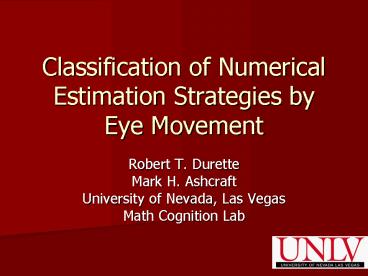Classification of Numerical Estimation Strategies by Eye Movement - PowerPoint PPT Presentation
1 / 29
Title:
Classification of Numerical Estimation Strategies by Eye Movement
Description:
Estimation is a mathematical skill that has rarely been studied. ... Michelle Guillaume. Alex Moore. Sintia Segovia. Ike Hurt. Karina Partida. Nathan Rudig. Questions? ... – PowerPoint PPT presentation
Number of Views:34
Avg rating:3.0/5.0
Title: Classification of Numerical Estimation Strategies by Eye Movement
1
Classification of Numerical Estimation Strategies
by Eye Movement
- Robert T. Durette
- Mark H. Ashcraft
- University of Nevada, Las Vegas
- Math Cognition Lab
2
Overview
- Estimation is a mathematical skill that has
rarely been studied. - An estimation task may have many different
context - This experiment focuses on non-contextual,
numerical estimation - Task is a simple number line used in grade
schools throughout the country
3
Overview
- Estimation performance on simple number lines in
1st through 6th grade has a relationship to
overall math performance - Adults have performed almost exclusively in a
linear fashion - But, adults may have an underlying logarithmic
mental representation
4
Goal of this Experiment
- Eye movements may reveal strategies that
individuals use when solving an estimation
problem - Detect an underlying logarithmic mental
representation
5
Method
- Subjects were asked to say out loud the number
that corresponds to a vertical hatch mark on the
number line - Number lines were 0 to 100
- 26 different number lines with two practice
trials at the beginning - 3, 4, 6, 8, 12, 14, 17, 18, 21, 24, 25, 29, 33,
39, 42, 48, 52, 57, 61, 64, 72, 79, 81, 84, 90
and 96
6
Example of 0 to 100 Stimulus
7
Eyetracking Analysis
- Divide stimuli into Areas of Interest (AOIs)
- Start Area, End Area and the Mark
- Number of Fixations
- Look Duration (ms) spent in each Area
8
Area of Interests
9
Area of Interests
10
Area of Interests
11
Area of Interests
12
Video of Eye Movements
13
Number of Eye Fixations on the Start Area
14
Video of Eye Movements
15
Number of Eye Fixations on the End Area
16
Eye Fixations on both the Start and End Areas
17
Number of Eye Fixations on the Mark
18
Fixations on the Start Area, End Area and the Mark
19
Area of Interests
20
Area of Interests
21
Look Duration (ms) on the Start Area
22
Look Duration (ms) on the End Area
23
Look Duration on both the Start and End Areas
24
Look Duration on the Mark
25
Look Duration on the Start Area, End Area and the
Mark
26
Conclusions
- Subjects do not appear to be using both end
points of the number line - As the mark decreases in value (towards the
beginning of the line), subjects do not use the
end area for estimation - As the mark increases in value (towards the end
of the line), subjects do not use the start area
for estimation
27
Next Step
- Complete the analysis of eye movement sequencing
- Complete the analysis of 0 to 1,000 and 0 to 723
number lines
28
Math Cognition Lab
- Caleb Orton
- Ricardo
- Tiffany
- Sandy Fung
- Timothy Lau
- Jaki
- Laura
- Elena
Mark Ashcraft Robert Durette Jeremy
Krause Michelle Guillaume Alex Moore Sintia
Segovia Ike Hurt Karina Partida Nathan Rudig
29
Questions?

